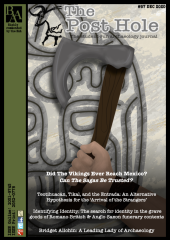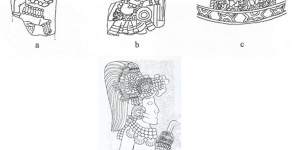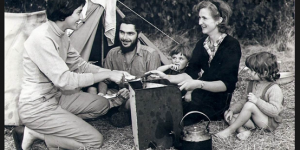Through an analysis of Romano-British and Anglo-Saxon funerary contexts this work outlines three forms of identity possible to interpret from grave goods; created identity, contradictory identity, and uncertain identity. In analyses of grave goods, a degree of uncertainty must be accepted in line with the post-processual principle of the equifinality of potentially valid hypotheses against archaeological data sets. Both the Romano-British and Anglo-Saxon periods illustrate the wider contemporary consideration in archaeological thought of grave goods as representing multiple idealised and composite identities projected on the deceased from those left alive (Fowler 2013, 511).
As an academic term, “grave goods” has been used to describe varying extents of material culture associated with funerary contexts, although it is used in here after Clarke (1975, 52) in reference to the intentionally deposited artefacts within a grave, excluding the body and grave structure (Sprague 2005). The term “Identity” can refer to various aspects of an individual or group; ethnicity, age, sex, gender, personhood, kinship, wealth, prestige, or rank (Fowler 2013, 512). In the culture history approach of early archaeological thought grave goods received attention for these latter aspects of identity (wealth, prestige, and rank) and as evidence of belief systems regarding the afterlife and the provisions required for the deceased. The increasingly critical advances in the archaeological theory with regards to identity and grave goods are outlined below.
The theoretical background
Binford’s “social persona” (1971, 17) called into question the legitimacy of a direct reading of grave goods as representing the identity of the deceased, where the identity presented after death is negotiated by those left alive, creating a composite persona of idealised aspects of the deceased’s identities from life (Goodenough 1965, 7). In this regard, from a processualist approach, it is possible to interpret the identity of the deceased from grave goods, particularly with regard to their social persona, although this understanding of grave goods is only a means to an end of interpreting larger social and economic processes. Binford’s (1971) approach has also been criticised for the narrow recognition of only a single identity at death, whereas those left alive may have each perceived the individual differently throughout the changing contexts of the mortuary process (Fowler 2013, 513).
An early work emphasising the variability of mortuary practice and the dangers of measuring the same archaeological evidence across multiple cultures is seen in Ucko’s (1969) ethnographic studies. For instance, whereas the high-ranking and wealthy priestly class of the Yoruba, Nigeria are buried without grave goods, amongst the Dahomey wealth correlates between both the volume of grave goods and factors such as the depth of burial (Ucko 1969, 267). What Ucko (1969) illustrates is how the extensive variety of ideologies across different cultures can produce a large variety of archaeological signatures. With regards to the interpretation of the identity of the deceased it is therefore uncertain what grave goods can reflect cross-culturally; a measure which is best interpreted in the context of other spheres of the society.
Hodder’s Symbols in action (1982) began a theoretical shift allowing for the consideration of artefacts not as mere passive reflections of social systems, but as symbols able to actively interact with and change social systems. The treatment of grave goods as equating directly to status and wealth, exemplified in the early readings of the Sutton Hoo ship burial, has been undermined by the post-processualist movement: it considers that material culture allows individuals to purposefully misrepresent themselves (Parker Pearson 1999, 9). Post-processualism also showed, in a much-referenced anthropological study of contemporary Cambridge by Parker Pearson (1982), that funerary treatment cannot be equated with wealth and status. It might also be noted that post-processual interpretations of grave goods are affected in practice with the concept of reflexive excavation; where interpretation is at the trowel’s edge as outlined by Hodder (1997, 2000), although this essay is concerned with the post-excavation interpretation of grave goods. The post-processual appreciation of context, the variability of possible interpretations, and the active role of symbology continue to characterise the interpretation of grave goods today.
Grave goods in Roman Britian
The study of Roman funerary archaeology has traditionally been concerned with the degree to which changing customs suggest a one-directional narrative of “Romanisation” (using grave goods in the “Roman way”) and to interpret the adoption of Christianity (Pearce 2000, 1; Barrett 1997; Cool 2011, 303). This has begun to change since the late 1990s, with a greater concern for ideological identity and how the dead were perceived by the living. Pearce (2000, 5) highlights how the major contribution of the post-processualists on Roman funerary archaeology is a consideration that the treatment of the dead does not directly reflect identity in life (Cool 2011, 300).
The aesthetic presentation of the deceased in an idealised manner is well documented in classical literature and funerary relief; with a period of lying in state followed by a procession in which the deceased would be carried through the streets in full view of pedestrians (Hope 2007, 100). Upon death the individual would be dressed in their finest clothes, in the case of men this was often a toga and the insignia of the highest offices held in life, with early Christian writers noting how the beautification of the deceased was akin to idol worship (Lindsay 2000, 163). An instance of a late Roman individual being buried with fine dress accessories can be seen in the recent excavation of a male burial from Lankhills, Winchester (Booth 2017). Here the individual was buried with a Roman style Crossbow brooch positioned by his shoulder, suggesting it was worn in the Roman style, yet the unusual position of a belt and riding boots (indicated by the spurs) beside his legs suggested additional interpretations for his identity which, for Booth (2017, 193-194), can only be speculative.
The use of grave goods in pre-conquest Iron Age Britain did not contrast greatly with the use of grave goods in the Roman period (consisting largely of personal ornaments), with some indigenous funerary traditions persisting into the Roman period (Philpott 1991, 6). By the turn of the 1st century CE the distinction between indigenous and Roman burial practices becomes less obvious, with the widespread introduction of Roman graves goods such as lamps, glassware and coins (found infrequently before the conquest) included in typically British barrow burials (Philpott 1991, 218). An example of this is seen in the excavation of six 2nd century CE barrow burials from Bartlow, Cambridgeshire, which contained Roman artefacts such as strigils and oil flasks for bathing and the remains of a folding-chair used by Roman magistrates (Cool 2011, 303).
As is the case with later Anglo-Saxon grave assemblages, it is perhaps the absence of grave goods which best signifies the adoption of the Christian religion. However, two burials of young elite women from Roman York contained grave goods with possible Christian connotations. The first of these is a teenage girl exhumed in the 19th century during the construction of York Railway Station (see Allason-Jones 2006). The lead and gypsum lined stone coffin suggest the elite status of the deceased, allowing the exceptional preservation of auburn coloured hair with hair pins still in place (Figure 1) (Allason-Jones 2006, 156). Made of jet, the pin heads are in the cantharus-headed form (a two handled Greek-style drinking vessel) which is suggestive of both the god Bacchus and of the Christian eucharist, with the Yorkshire jet suggestive of long-held local spiritual connotations (Allason-Jones 1996 and 2006, 157).
A more elaborate instance of Christian identity in Roman Britain is that of an elite mixed-race woman excavated at Sycamore Terrace, York (Cool 2006; Leach et al. 2010). The 4th Century CE assemblage consisted of a fine blue-glass perfume jug, a crystal mirror, glass beads and earrings, two jet bracelets, four elephant ivory bracelets, silver and copper pendants and an openwork bone plaque reading “SOROR AVE VIVAS IN DEO” (“Hail sister, may you live in God”) (Figure 2) (Cool 2006, 155-156; Ottaway 2004,137). More than signs of elite or Christian status, these artefacts can be perceived as evidence for an identification with North Africa, as the Romans’ association of ivory with the exoticism of Africa compliments the mixed-race identity of the individual, perhaps showing a desire to identify with both an ancestral home and, through the use of jet, Yorkshire (Leach et al. 2010, 141; Leach et al. 2009).

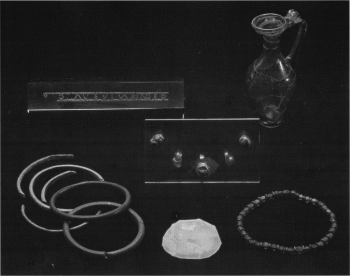
Graves goods in Anglo-Saxon England
Anglo-Saxon funerary archaeology has a tradition of interpreting identity from grave goods, particularly gender, status, ethnicity, migration patterns and, more recently, constructed and ideological identity (Lucy 2000, 14, 174). Lucy (2000, 87) groups grave good burials into three types; those with weaponry, which are usually male; those with jewellery, which are usually female; and the remaining minority with other artefact types. The unusual grave goods of the third type include those with tools, drinking and cooking vessels, musical instruments, gaming pieces, and horse harnesses (Hӓrke 2014, 43). Occasional “non-functional” artefacts are found suspended from belts, such as perforated spoons and girdle hangers, and are argued to have held an “amuletic” function (Lucy 2000, 44), although the domestic connotations these items held may have been important signifiers of identity within themselves.
With regards to archaeological theory, recent Anglo-Saxon funerary archaeology research falls in line with post-processualism in the consideration of symbology and in the acceptance of a plurality of interpretations. However, both the processual study of the economics of grave goods and the post-processual study of their symbology has been argued by King (2004, 216) to rest on the false assumption that grave goods belonged, or were presented as belonging, to the deceased they are buried with. For King (2004, 218, 224) Anglo-Saxon grave goods were often “gifts”, an argument based on the duplication of grave goods, their spatial division which would have increased visibility to a funerary audience, and ethnographic analogy with funerary gift-giving.
However, King’s (2004) analysis appears speculative, and the selective use of ethnographies perhaps provides little more than an engaging theory best appreciated in conjunction with other ways of understanding the purpose of grave goods. A more nuanced interpretation of the meaning of Anglo-Saxon grave goods is presented by Hӓrke (2014, 41), stating that above all it is the multiplicity of messages and the variability of meanings which characterise the use of grave goods in early medieval graves. Hӓrke (2014, 52) details multiple explanations for the use of Anglo-Saxon grave goods; such as for ostentatious destruction, the burial of inalienable property, and gift-giving, acknowledging that ultimately the different reasons are not strictly separate and may have existed simultaneously in single funerary contexts.
Carver (2000, 39) states that if any explanation for the use of grave goods in the Anglo-Saxon period can be discerned, it is perhaps best derived from the larger assemblages we have, namely, the Sutton Hoo ship burial. Interpretations of the identity of the deceased buried at Mound 1 have paralleled the consideration of grave goods elsewhere in Anglo-Saxon archaeology. For Bruce-Mitford (1968, 44), the grave goods were intended as with the “pagan view”, to be used in the afterlife by the deceased, also signifying their high-status. The further inference is that this is the burial of the East Anglian King Redwald, suggested by the whetstone and standard’s royal connotations and comparisons in Beowulf, although it might be noted that more recent research appears less certain, indeed even less concerned, with the historic naming of the individual (ibid. 52-53).
Beyond the immediate expense of the Mound 1 grave goods, with regards to the man-hours involved in the sourcing of materials and crafting of artefacts, are the implications for the appropriation of style from across the old world. The imported grave goods include Frankish coins, an Egyptian bowl, and Byzantine silver, including Christian-inscribed spoons (Figure 3) interpreted by Owen-Crocker (2000, 31) as the deceased’s desire to cultivate an exotic funerary atmosphere. The Sutton Hoo helmet (Figure 4) also represents affiliations with other cultures. The Swedish style, paralleled in the chiefdom graves of Vendel (Figure 5) and Valsgӓrde (itself derived from a style of Roman helmet) suggests a unique English style at Sutton Hoo, perhaps also seen in the c.700 CE Coppergate Helmet (Figure 6) from York with comparable deep ear-flaps and solid cap (Owen-Crocker 2000, 67; Maryon 1947, 144; Care Evan 1986, 49).
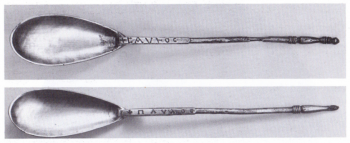
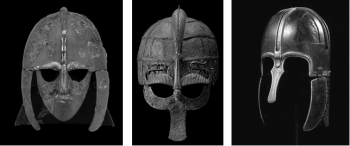
Discussion
One of the key themes to emerge from the Romano-British use of grave goods is the creation of new identities: seen in the use of Roman artefacts in British burial mounds at Bartlow, Cambridgeshire, and the use of both local and continental artefacts at Sycamore Terrace, York, symbolising concepts as formerly disparate as North African ancestry and local spiritual beliefs through the use of ivory and Whitby jet (Cool 2011, 303; Leach et al. 2010, 141; Allason-Jones 1996). This conscious effort to form a created identity of the deceased after death can also be seen in the Anglo-Saxon use of grave goods; particularly the unprecedented composite identity seen from Mound 1 at Sutton Hoo. When compared with other examples from Northern Europe and England, the Sutton Hoo helmet suggests a new, concerted, and created identity projected onto the deceased. The use of grave goods from multiple cultures can be said to identify the deceased as a worldly individual, perhaps with a large sphere of influence. However, it may be more correct to say this was the identity that the mourners had created.
A further theme of identity in the archaeology of Romano-British and Anglo-Saxon grave-goods is that of contradictory identity. The burial at Sycamore Terrace, where the bone mount suggests Christian belief in contrast to grave goods synonymous with vanity, which the contemporary Christian Church opposed, suggests an ideological contradiction. Likewise, the Byzantine silverware from Sutton Hoo which connotes Christian belief simultaneously with pre-Christian imagery, may suggest an ideological contradiction. Were the deceased and actors of the funeral at Sutton Hoo, as Lucy (2000, 182) suggests, attempting in the use of non-Christian northern European imagery, to identify themselves with ideologies opposed to Christianity? This opposition might be expected towards the predatory agenda of nearby Christian powers in Kent and France (Carver 2000, 47). Whilst this perspective might be seen as difficult to reconcile with the presence of Byzantine artefacts, Carver (1992, ix-x) accepts the inconsistencies of symbolism at Sutton Hoo as an effort to forge a composite identity, contradictory though the identity may appear.
These cases from Romano-British and Anglo-Saxon England suggest another form of identity: that of uncertain identity. Whilst both periods have the benefit of contemporary written accounts, these do not go far enough to help interpret all of the complexities of identity or the use of grave goods. Ethnographic analogy offers another comparative form for the interpretation of grave goods. However, as a critique of King’s (2004) study of the gift-giving of Anglo-Saxon grave goods highlights, the use of ethnography can be dangerous when used selectively. This is not to say that the use of ethnography, as outlined by Ucko (1969), is not valuable in assisting archaeological interpretations in the raised awareness of the variability of grave good use. In the case studies discussed above, uncertainty is best exemplified in “non-functional” artefacts in Anglo-Saxon graves, to which no satisfactory explanation can be given, and in the Romano-British case of a man inexplicably buried beside riding boots and a belt (Lucy 2000, 44; Booth 2017, 195).
The high level of uncertainty in the identification of identity through the analysis of grave goods in the archaeological record is a real, if unfortunate, consequence of accepting the anti-positivist fallibility of all archaeological data. The concrete identities of cultural historians, even the social persona of Binford’s (1971) processualism, are much more appealing prospects to the minds of archaeologists and the public alike. However, in accepting the post-processual concept of the equifinality of “provable” hypotheses, the ultra-complex and culture-specific/contextual role of symbology, and the person-to-person subjectivity of perspectives towards the identity of the deceased, we see that such concrete assertions about identity as derived from grave goods can now live only in fiction.
Conclusion
In the Romano-British and Anglo-Saxon periods grave goods were used by communities to signify multiple, idealised, and composite identities for the deceased, which were projected from the active perspectives of multiple individuals. The three forms of identity discerned in this essay, created, contradictory, and uncertain identity, are not separate forms of identity and are only terms for discussion. The post-processual critique has shown that it is this exploration of analysis and the explicit recognition of uncertainty which can best produce nuanced understandings of the matrix of identities possible to interpret from grave goods.


